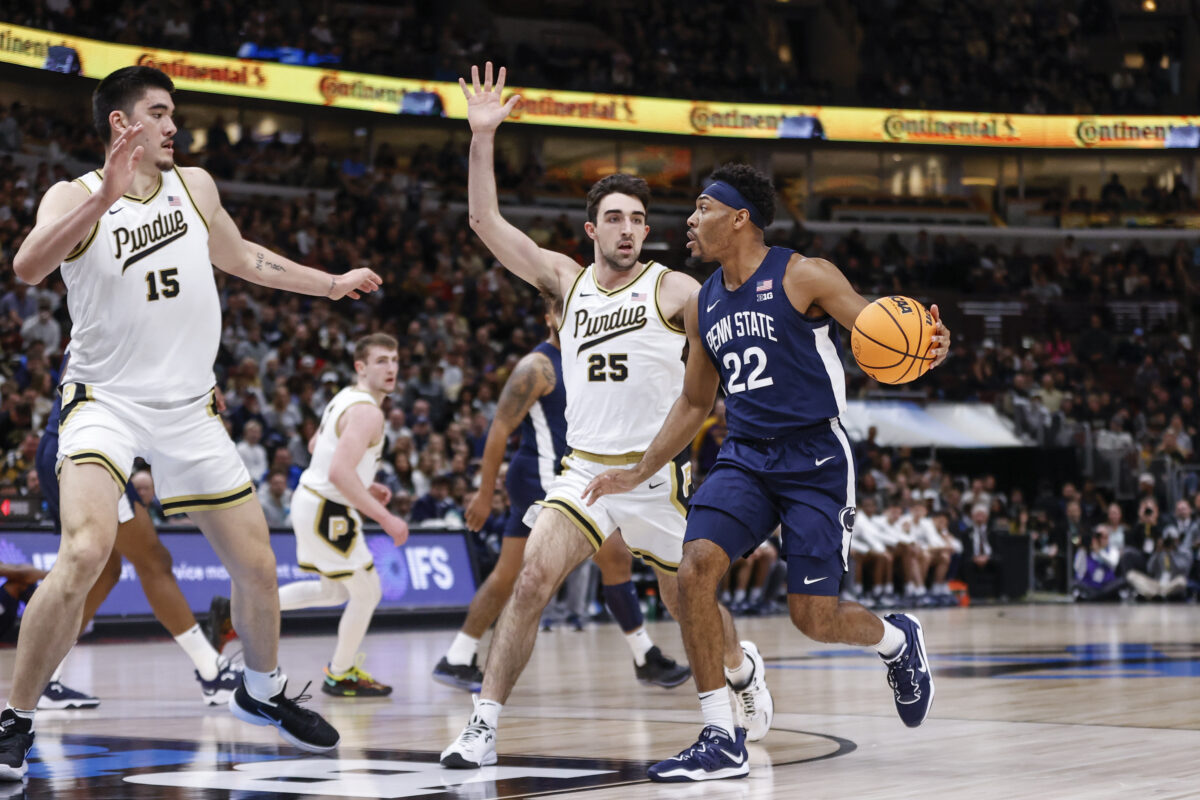Penn State had one of the most exciting March runs in recent program history. Coming into the tournament, they were firmly on the NCAA Tournament bubble.
They put themselves into the tournament with wins over Illinios and Northwestern on their way to their semifinal appearance. But they weren’t satisfied by just playing in the game. They beat Indiana to play in their second ever conference championship game and cement themselves in NCAA Tournament.
That run ended on Sunday after falling to Purdue 65-67.
Penn State made a flurry at the end of the game to come within one possession and a shot to win the game. They failed to get a shot off as [autotag]Camren Wynter[/autotag] was called for a travel before the shot attempt.
It was going to be a tall task to beat the Boilermakers who had beat them twice during the regular season. The best team in the Big Ten all season, Purdue is also expected to be a one seed when the bracket is released.
Penn State hit their first two buckets of the game to lead 4-0, but missed their next six shots. This got them into an early hole and they trailed by their largest margin of the entire tournament.
The Nittany Lions were fighting an uphill battle the entire first half as they tried to stay in the game. They were able to keep the margin close and went into halftime down 27-35.
The uphill battled continued all second half as Purdue kept pounding them in the paint and on the offensive glass. The Boilermakers pulled down 13 offensive rebounds and kept possessions alive they ultimately capitalized on.
With six and a half minutes to go, it looked like Purdue was going to run away with the game. They were up 17 points and had Penn State out of sorts.
But Penn State would not go away. They started chipping away at the lead with basket after a basket from their seniors.
After a dunk from freshman [autotag]Evan Mahaffey[/autotag] with just under three minutes remaining, Penn State trailed 58-64.
[autotag]Jalen Pickett[/autotag] cut the lead to four points after two made free throws, but Big Ten Player of the Year, [autotag]Zach Edey[/autotag], made a layup through a triple team to put the lead back up to six.
After [autotag]Andrew Funk[/autotag] missed a three, Purdue was fouled and on free throw line looking to put the game away for good.
Freshman guard [autotag]Fletcher Loyer[/autotag] missed both free throws and Penn State senior guard [autotag]Myles Dread[/autotag] hit a three to cut the lead to three points.
The ending got crazy after Purdue turned the ball over in the backcourt on the steal from Mahaffey. Wynter hit a layup to unbelievably cut the lead to one point with seven seconds remaining.
Loyer was on the line again for Purdue. He made the first one but missed the second giving Penn State an opportunity to win or tie the game.
They advanced the ball into the front court and called a timeout to set up the potential game-winning shot.
When Pickett inbounded the ball, it was tipped and created a scramble play to get up a shot.
Dread came up with the ball and found Wynter who has hit clutch shots for Penn State all season. He pump-faked once and then shuffled his feet when trying to get a clean look.
Travel. Game over.
[autotag]Seth Lundy[/autotag] led the Nittany Lions with 19 points and 8 rebounds. Wynter added 14 points and Pickett finished with 11.
Probable NCAA Player of the Year, Edey, finished with a game-high 30 points and 13 rebounds. [autotag]David Jenkins Jr.[/autotag] and [autotag]Mason Gillis[/autotag] joined him in double figures with 11 and 10 points respectively.
It was definitely a tough loss to stomach for Penn State and all its seniors. The magical postseason tournament run ended in heart breaking fashion.
But what a run it was!
Head coach [autotag]Micah Shrewsberry[/autotag] did an excellent job getting all the players to buy in and believe they could make this run. After coming into the tournament with questions about their March Madness hopes, they left no doubt they are a tournament team.
[lawrence-auto-related count=5 category=11]
[mm-video type=video id=01gvbhf2wk3s5v5vatf2 playlist_id=01ey902ehrs6e9bvhw player_id=01eqbvp13nn1gy6hd4 image=https://images2.minutemediacdn.com/image/upload/video/thumbnail/mmplus/01gvbhf2wk3s5v5vatf2/01gvbhf2wk3s5v5vatf2-cdb2365114e90df88c0a132c0dfe7467.jpg]

